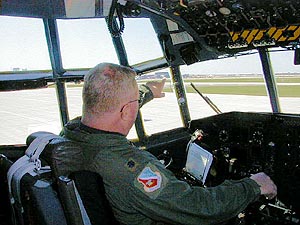|
Photos
More from MPR
Resources
Your Voice
|
Museum features Air Guard's history and role in the war on terror
May 31, 2004
 |
| Lt. Col. Steve O'Brien points to the position where the flight crew of flight Gopher 06 saw American Airlines flight 77 shortly before it crashed into the Pentagon on 9/11. (MPR Photo/Bill Catlin) |
St. Paul, Minn. — Walk into the remodeled facility on the Air Guard's base, and you'll see mannequins in protective gear, a videotape, and photos of current Minnesota Air Guard aircraft.
 | |||
Retired guardsman Dick Wiessner, vice-chair of the museum's board, says he hopes visitors will get a better understanding of the guard's role and capabilities.
"This country exists because of the Guard, from way, way back, from the day of its origination," says Wiessner.
A new exhibit showcases Minnesota's current Air Guard units and their role in the war on terror. The Duluth-based 148th Fighter Wing's F-16s flew more hours patrolling cities after 9/11 than any other air defense unit. The Twin Cities-based 133rd Airlift Wing operates C-130 transport aircraft, which have supported the campaigns in Iraq and Afghanistan.
A video tells the story of flight Gopher 06, a Twin Cities-based C-130 leaving Washington, D.C. the morning of 9/11. An emotional looking Maj. Robert Schumacher describes how air traffic controllers directed the crew to follow American Airlines flight 77, shortly before it crashed into the Pentagon. The Air Guard crew wasn't aware of the attacks in New York.
 | |||
Schumacher thought the airliner must be in trouble: "that the pilots were really just trying to fly the airplane, and get it on the ground safely," Schumacher says in the videotape. "I remember looking out my right side windows, kind of down on it, and just having the hairs on the back of my neck standing up and having this sinking feeling that something was going to happen. I remember thinking, 'God, just let them land safely.'"
In a recent interview, Lt. Col. Steve O'Brien, commander of Gopher 06, says he remembers seeing a big explosion. He says this fireball was quite a bit bigger than the one he'd seen when a classmate crashed.
"I just remember telling Washington, 'Washington, that airplane has hit the ground.' And right away, I got real upset inside, because you know it was like a fellow aviator had just crashed an airplane in front of me again, or aviators, in this case," says O'Brien. "It's like a part of you dies when somebody in your own business has a mishap like that."
|
I remember thinking, 'God, just let them land safely.'
- Maj. Robert Schumacher |
Through the haze the shape of the Pentagon emerged where the explosion had occurred. The crew alerted the controllers and tuned in a newscast using navigation radios.
"The first thing we heard on there was 'We're now hearing about a second airplane hitting the World Trade Center.' That was not what we were expecting to hear. We were expecting to hear about an airplane impacting the Pentagon, and they haven't even mentioned that yet," says O'Brien. "They're just talking about a second airplane hitting the World Trade Center, and the light goes on, and it's like, 'Oh my God, the nation's under attack!'"
Not long after, Gopher 06 was in the vicinity, and reported the smoke when the fourth plane crashed into a Pennsylvania field.
O'Brien says the emotion can still well up and surprise him occasionally, and there was another surprise--the story turned up on the Internet as part of a conspiracy theory maintaining that no plane hit the Pentagon.
"To be called a liar and a part of a government conspiracy kind of affected me too, because it just scares you a little bit that there might be some kooky people out there that might want to do harm to you or your family because they feel you're part of some government conspiracy," says O'Brien.
For his part, flight engineer Master Sgt. Jeffrey Rosenthal, is more than ready to move on after much well-meaning curiosity and concern.
"We're no different than anybody else. We're your neighbors; our kids go to your schools; we shop where you shop. We're just regular people that go to work, and got caught in an unfortunate circumstance," says Rosenthal.
But he also says that circumstance changed everything in both his personal and professional lives. He has since been on Guard missions to Afghanistan, Pakistan, Kuwait, Qatar, Oman and Iraq.
The Minnesota Air National Guard Museum will be open again next Saturday.
|
News Headlines
|
Related Subjects
|
